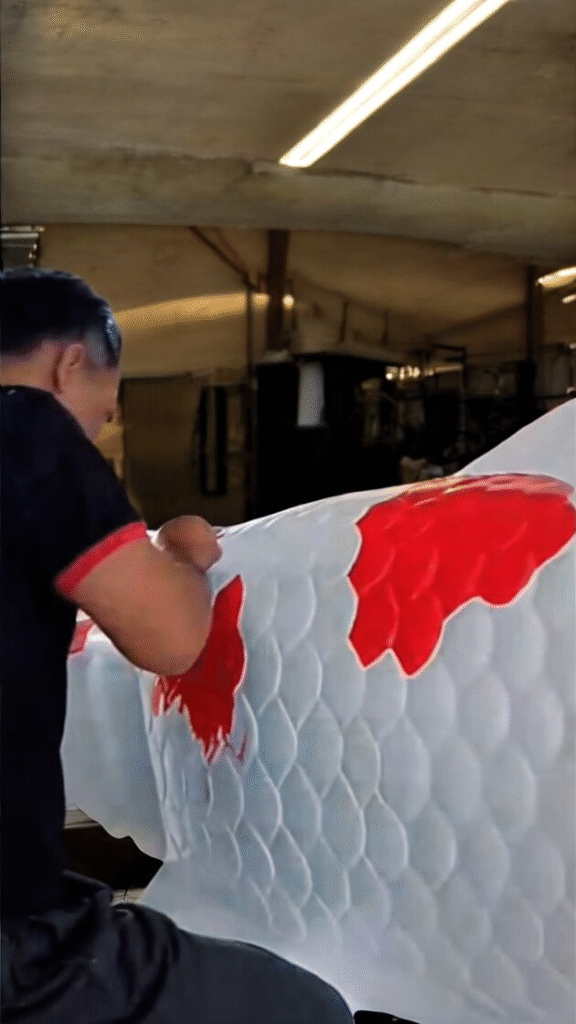
When winter rolls around, it brings more than just chilly nights and cozy sweaters—it also brings potential trouble for your beautiful outdoor décor. If you own a fiberglass koi fish statue, you’ve probably admired how it adds charm and life to your garden or pondside. But winter can be rough on fiberglass if you’re not careful. Don’t worry, though! With a few simple steps, you can make sure your statue stays just as stunning in spring as it was in summer. Here’s how to maintain a fiberglass koi fish statue in winter without any stress.
1. Clean It Before Winter Hits
Before the frost settles in, give your koi fish statue a good cleaning. Use mild soap, warm water, and a soft cloth or sponge to gently remove dirt, algae, bird droppings, and any buildup from rain or garden debris. Why is this important? Because grime and moisture trapped under snow or ice can lead to long-term damage like surface peeling or mold. Dry it thoroughly after washing—it’s a small step that makes a big difference. You want your statue to face the cold clean and dry, not grimy and vulnerable.
2. Move It to a Safe Spot (If You Can)
Fiberglass is durable, but it’s not invincible. If your statue is lightweight and easy to move, the best thing you can do is relocate it to a sheltered spot like a garage, shed, or even a covered patio. This gives it full protection from snow, sleet, and freezing rain. If moving it indoors isn’t an option, try to place it under an overhang or wrap it in a waterproof tarp. Make sure the cover is secure but breathable—trapping moisture underneath is a no-go. Even a little protection goes a long way when you’re dealing with winter weather.
3. Apply a Protective Coating
One smart way to prepare your statue for winter is by applying a clear protective coating. You can easily find a UV-resistant, waterproof sealant made specifically for fiberglass at your local hardware store. This extra layer acts like a winter jacket for your statue, shielding it from moisture, freezing temperatures, and even sun damage during those rare but intense sunny winter days. Reapply the coating once a year—right before winter sets in is the perfect time. Think of it as your koi statue’s armor against the elements.
4. Check for Cracks and Repair Early
Before winter truly sets in, take a few minutes to inspect your fiberglass koi statue for any tiny cracks, chips, or signs of wear. Even the smallest damage can expand when exposed to freezing temperatures and moisture. Water can seep into those cracks, freeze, and cause the fiberglass to split further. If you spot any damage, don’t wait—use a fiberglass repair kit or a waterproof epoxy to patch it up right away. This small maintenance step can prevent a small issue from turning into a full-blown statue disaster.
5. Elevate It Off the Ground
Here’s a clever trick many people forget: elevate your statue just a few inches off the ground. Use bricks, stones, or a small platform to lift it slightly. Why? Because direct contact with cold, frozen ground can lead to frost damage and pooling water around the base. Elevating your statue helps water drain away, reduces the risk of ice buildup, and adds an extra layer of protection. Plus, it gives your koi a little stage to shine—even in the middle of winter.
Wrapping It Up
So, how to maintain a fiberglass koi fish statue in winter? It’s really all about being proactive. A quick clean, a little relocation, and a smart layer of protection can keep your statue looking flawless no matter how frosty the weather gets. Taking just a bit of time before the first snowfall can save you from expensive repairs or replacements in the spring.
Your koi statue is more than just decoration—it’s a symbol of peace, luck, and beauty. Treat it with care, especially when the weather turns tough, and it’ll keep bringing charm to your outdoor space for years to come. Stay warm, and keep your koi smiling!
